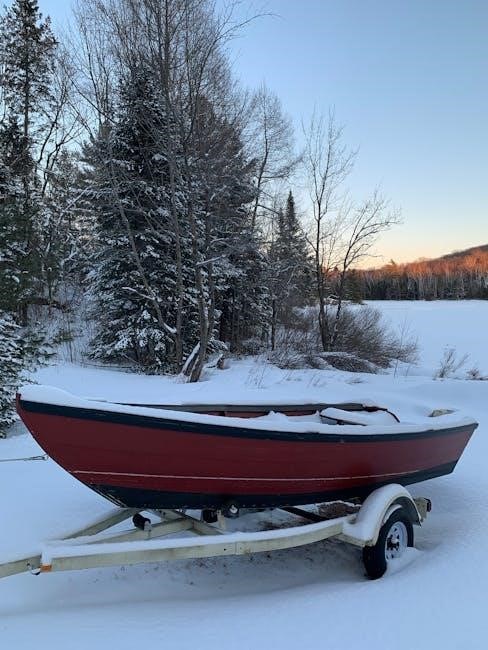Roller guide-ons are essential accessories for boat trailers, designed to facilitate smooth and efficient loading and unloading. They minimize hull damage and improve alignment on shallow ramps, ensuring a stress-free boating experience.
What Are Roller Guide-Ons?
Roller guide-ons are systems designed to assist in centering and aligning a boat on its trailer during loading and unloading. They typically consist of vertical uprights with smooth-rolling mechanisms and end caps to protect the boat’s finish. These guides are mounted on the trailer frame and help stabilize the boat, ensuring proper alignment, especially on shallow ramps. They are a practical solution for various boat types, including ski boats, fishing boats, and sailboats, making the loading process safer and more efficient.
Why Are They Essential for Boat Trailers?
Roller guide-ons are crucial for boat trailers as they enhance safety, protect the boat from damage, and improve loading efficiency. They provide a guided path for the boat, reducing the risk of hull damage and misalignment, especially on shallow ramps. Their adjustable and customizable design accommodates various boat types, ensuring a secure fit. Durable materials and smooth-rolling mechanisms minimize friction and maintenance needs, while their ability to stabilize the boat during transport reduces accident risks. Overall, they make the loading and unloading process easier and safer, enhancing the boating experience.

Types of Roller Guide-Ons
Roller guide-ons come in adjustable or fixed designs, with manual or automatic centering systems. They also feature swivel or stationary rollers, offering versatility for different boat trailer setups and preferences.
Adjustable vs. Fixed Guide-Ons
Adjustable guide-ons offer customization, fitting various boat widths, while fixed guide-ons provide simplicity. Adjustable models are ideal for multiple boats or changing setups, ensuring proper alignment. Fixed guide-ons are durable, suited for consistent use. Both enhance loading efficiency and protect hulls, but adjustables offer flexibility for different-sized boats, making them versatile for various trailer configurations and boating needs.
Manual vs. Automatic Centering Systems
Manual centering systems require adjustments to align the boat properly, offering precise control but needing more effort. Automatic systems self-align, simplifying the process. Manual systems are cost-effective and reliable, while automatic ones provide convenience and speed, especially for frequent use. Both ensure proper boat alignment, but automatic systems reduce labor, making them ideal for those prioritizing ease and efficiency in loading and unloading their boats on trailers.
Swivel vs. Stationary Rollers
Swivel rollers allow lateral movement, enabling the boat to align effortlessly, while stationary rollers provide fixed support. Swivel rollers reduce stress on the trailer frame during loading and unloading, making them ideal for boats that require more flexibility. Stationary rollers, however, offer consistent stability and are better suited for smaller boats or those with straightforward loading needs. Both types enhance loading efficiency but cater to different boating requirements and trailer setups.

Key Features of Roller Guide-Ons
Roller guide-ons feature smooth-rolling mechanisms, durable materials, and adjustable designs. They provide excellent support, reduce friction, and protect the boat’s hull during loading and unloading processes.
Smooth Rolling Mechanisms
Smooth rolling mechanisms are designed to facilitate effortless boat alignment and centering on the trailer. These systems reduce friction, ensuring minimal wear on the boat’s hull. Constructed with durable materials like nylon or rubber, they provide consistent performance. The rollers glide smoothly, making loading and unloading easier, even on shallow ramps. This feature enhances overall efficiency, reducing the risk of damage and stress during the process.
Durable Materials and Construction
Roller guide-ons are crafted from high-quality materials, such as stainless steel, galvanized steel, or durable polymers, ensuring resistance to rust and corrosion. Their robust construction withstands harsh marine environments and heavy use. Heavy-duty frames and secure mounting systems provide long-lasting reliability. The sturdy design minimizes wear and tear, offering consistent performance over time. This durability ensures the guide-ons remain functional and reliable, even in challenging conditions, protecting your boat and trailer investment.
Adjustability and Customization Options
Roller guide-ons often feature adjustable mechanisms, allowing customization to fit various boat sizes and trailer setups. This adaptability ensures a secure fit for different hull shapes and sizes, enhancing loading efficiency. Users can fine-tune the guide-ons to align perfectly with their boat, reducing the risk of damage and simplifying the process. Some models offer quick-release or variable tension settings, providing added convenience and ensuring a tailored fit for optimal performance.

Installation and Setup Guide
Proper installation ensures optimal performance. Measure and align guide-ons with your boat’s hull, then secure them firmly to the trailer frame for safe, efficient use.
Step-by-Step Installation Process
Begin by positioning your boat on the trailer and ensuring it is centered. Measure the width of your boat’s hull to determine the optimal placement for the guide-ons. Mount the guide-ons to the trailer frame using sturdy hardware, ensuring they are level and secure. Adjust the rollers to gently touch the hull without applying pressure. Tighten all bolts firmly and test the system by loading and unloading the boat to ensure smooth operation and proper alignment.
Choosing the Right Location for Guide-Ons
Proper placement of guide-ons is crucial for effective functionality. Start by positioning the boat on the trailer and measuring the hull width to determine optimal guide-on location. Ideally, they should be mounted near the trailer’s midpoint, ensuring even support. Place them 12-18 inches from the rear of the trailer to avoid interfering with the boat’s movement. Adjust the guide-ons to align with the boat’s natural centerline for balanced loading and unloading. Ensure they are not too tight or too loose to allow smooth operation.
Securing the Guide-Ons to the Trailer Frame
Securing guide-ons requires precise alignment and sturdy hardware. Begin by attaching the guide-ons to the trailer frame using high-strength bolts and washers. Ensure they are tightly fastened to prevent movement during loading or unloading. Use backing plates for added reinforcement, especially on thinner trailer frames. Align the guide-ons with the boat’s hull to maintain even pressure and prevent damage. Double-check all connections to ensure a snug, secure fit for reliable performance.

Benefits of Using Roller Guide-Ons
Roller guide-ons enhance loading efficiency, reduce hull damage, and improve alignment on shallow ramps. They provide smooth, controlled movement, making trailer operations safer and less stressful for boat owners.
Improved Loading and Unloading Efficiency
Roller guide-ons significantly enhance the efficiency of loading and unloading your boat. By providing smooth, consistent movement, they guide the boat onto the trailer with minimal effort. This reduces the time spent aligning the boat and eliminates the frustration of manual adjustments. The rollers allow the boat to center itself automatically, ensuring a seamless process. This feature is particularly beneficial in challenging conditions, such as shallow ramps or tight spaces, making the entire operation faster and less stressful for boat owners.
Reduced Risk of Hull Damage
Roller guide-ons play a crucial role in protecting your boat’s hull from potential damage. By providing a smooth, controlled path during loading and unloading, they minimize the risk of scratches or dents caused by abrupt movements. The rollers act as a protective barrier, absorbing shocks and distributing pressure evenly. This ensures your boat remains safe and securely guided, even in challenging conditions. Durable materials, such as rubber, further enhance this protective function, safeguarding your vessel’s finish and structural integrity.
Easier Alignment on Shallow Ramps
Roller guide-ons significantly simplify the process of aligning your boat on the trailer, especially on shallow ramps. Their smooth-rolling mechanism ensures the boat centers itself effortlessly, reducing the risk of misalignment. This is particularly beneficial in shallow water, where the trailer isn’t fully submerged, making manual adjustments challenging. The guide-ons stabilize the boat’s movement, minimizing wobbling and ensuring a straight, controlled approach. This feature is invaluable for boat owners who frequently load and unload their vessels in less-than-ideal conditions, providing peace of mind and saving valuable time.

Maintenance and Care Tips
Regularly clean and lubricate rollers to ensure smooth operation. Inspect for wear and tear, replacing damaged parts promptly to maintain functionality and prevent corrosion.
Cleaning and Lubricating the Rollers
Regularly clean rollers with mild detergent and water to remove dirt and debris. Rinse thoroughly and dry to prevent rust. Lubricate with marine-grade grease, especially after exposure to water. This ensures smooth operation and extends lifespan. Always inspect rollers during cleaning for signs of wear or damage. Replace worn parts promptly to maintain optimal performance and prevent corrosion. Proper maintenance keeps your guide-ons functioning effectively, ensuring safe and efficient boat loading and unloading.
Inspecting for Wear and Tear
Inspect rollers regularly for cracks, rust, or worn surfaces. Check moving parts for smooth operation and ensure all hardware is secure. Look for uneven wear, which may indicate misalignment. Replace any damaged or excessively worn components promptly. Routine inspections help prevent failure during loading or unloading. Pay special attention to areas exposed to water, as they are prone to corrosion. Addressing wear early ensures long-term functionality and safety of your boat trailer guide-ons.
Replacing Damaged or Worn-Out Parts
Replace damaged or worn-out parts immediately to maintain optimal performance. Inspect rollers, brackets, and hardware for signs of wear. If a roller is cracked or rusted, swap it with a new one. Ensure replacement parts are compatible with your guide-ons’ make and model. Tighten all bolts securely after installation. Regular replacement prevents further damage and ensures smooth boat loading. Source high-quality components from trusted manufacturers or retailers to guarantee durability and reliability.

Common Mistakes to Avoid
Common mistakes include incorrect installation, overloading guide-ons, and neglecting maintenance. Ensure proper alignment, avoid exceeding weight limits, and regularly inspect for wear to prevent issues.
Incorrect Installation and Alignment
Incorrect installation and alignment of roller guide-ons can lead to poor performance and potential damage. Ensure guide-ons are properly secured to the trailer frame and aligned with the boat’s hull. Misalignment can cause uneven wear on rollers and make loading difficult. Avoid installing guide-ons too far apart or at the wrong angle, as this may result in improper centering of the boat. Always follow manufacturer instructions for installation and adjust guide-ons carefully to fit your boat’s specific needs.
Overloading the Guide-Ons
Overloading the guide-ons can lead to premature wear and potential damage. These components are designed to assist with alignment, not to support the full weight of the boat. Excessive force or weight can bend the guide-ons or damage their rollers, compromising their effectiveness. Always use a winch or straps to secure the boat properly, rather than relying solely on the guide-ons for support. This ensures optimal performance and extends the lifespan of the guide-ons.
Neglecting Regular Maintenance
Neglecting regular maintenance can significantly reduce the effectiveness and longevity of roller guide-ons. Dirt, rust, and wear on the rollers can cause friction, making loading and unloading difficult. Corrosion from exposure to water and salt can weaken the structure. Failing to lubricate moving parts and inspect for damage leads to premature wear and potential failure. Consistent cleaning and upkeep ensure smooth operation and protect your investment, keeping your guide-ons functioning optimally for years.
